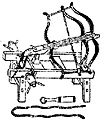Crossbow facts for kids
A crossbow is a type of weapon that fires projectiles called crossbow bolts or quarrels. Most sources point to its invention in China, while others point to it being a Norman invention, but the crossbow nonetheless played a significant role in the history of European medieval warfare and is still used in modern times for various purposes.
Description
A crossbow consists of a prod (similar in appearance to a bow) mounted on a stock similar to a rifle stock, which has a mechanism to wind and shoot its bolts. These bolts are typically called quarrels. The stock and trigger of hand-held firearms may have been copied from crossbows.
A crossbow contains a string which is held in place by a nut when the bolt is loaded and the cross bow is engaged. Typically, the nut is at the end of the shelf (also called the bolt rest).
The bow and stock of a crossbow were made of good hardwood, such as oak or hard maple. The prod is attached to the stock with hemp rope, linen, whipcord, or other strong cording. The crossbow shelf is a flat section above the stock with a straight groove for the bolt to rest upon and travel along as it is shot.
The strings for a crossbow are typically made of strong fibers that would not tend to fray. Linen, hemp, and sinew were used as well. Even cotton was tried with some success.
The crossbow also includes a trigger, which was later incorporated into rifles, muskets and other firearms. Triggers are known to have been used on crossbows from the early 1400s.
Leonardo da Vinci designed many complicated triggers for crossbows, ultimately producing a "hair trigger" that could be shot with very little finger strength.
Crossbows were eventually replaced in warfare by gunpowder weapons. Early guns had slower rates of fire and much worse accuracy than contemporary crossbows. Crossbow shooting is today a popular sport. Modern crossbows are still used for target shooting and in some places for hunting. They are made of the same composite materials as modern bows.
Images for kids
-
Han dynasty crossbow trigger pieces.
-
Arrowheads and lead balls, Han dynasty
-
The reticle of a modern crossbow telescopic sight allows the shooter to adjust for different ranges
-
A bronze crossbow trigger mechanism and butt plate that were mass-produced in the Warring States period (475–221 BC)
-
A miniature guard wielding a handheld crossbow from the top balcony of a model watchtower, made of glazed earthenware during the Eastern Han era (25–220 AD) of China, from the Metropolitan Museum of Art.
-
Wheelmounted and elephantmounted double-bow-arcuballistae in the Khmer army, possibly Cham mercenaries
-
Greek gastraphetes
-
Sketch by Leonardo da Vinci, c. 1500
-
Battle scene depicting a man spanning a crossbow using a winch mechanism, possibly mounted on a frame, Han dynasty
-
Song dynasty cavalry wielding crossbows with stirrups
-
Cocking of a Greek gastraphetes
-
Earliest European depiction of cavalry using crossbows, from the Catalan manuscript Four Horsemen of the Apocalypse, 1086.
-
Late medieval crossbowman from ca. 1480
-
Early modern four-wheeled ballista drawn by armored horses (1552)
-
Fisheries scientist obtaining tissue samples from dolphins swimming in the bow wave of a NOAA ship
See also
 In Spanish: Ballesta para niños
In Spanish: Ballesta para niños












































